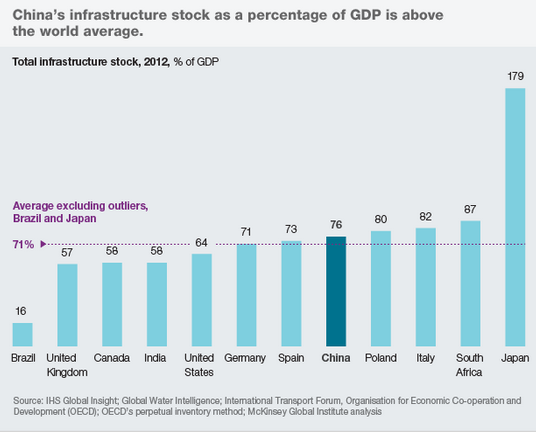But that’s mostly because it’s a pathetically poor country. Here’s is China’s infrastructure as a share of GDP:
China’s infrastructure as a share of GDP is fairly normal, but because its GDP per capita is so much lower than developed countries, it’s stock of infrastructure per capita is also far lower. The real outlier is Japan, which did an orgy of infrastructure spending to boost AD, even as its central bank pursued a deflationary monetary policy, and ended up with lots of bridges to nowhere, and falling NGDP.
Yes, there is some infrastructure in the wrong place; Ordos, or the Binhai area of Tianjin. But for the most part it’s where it should be:
1. The subways are under the huge, densely populated cities, where they should be.
2. The high speed rail mostly connects big cities.
3. The larger ports and airports are mostly near the bigger cities.
4. The motorways mostly connect highly populated areas in eastern China.
5. The housing is mostly being built in the cities that are receiving massive rural to urban migration.
And remember, if China ever becomes developed it will need far more housing, subways, airports, roads, rail, water systems, power, etc, etc, than it has now.
China’s in a sweet spot where the inefficient SOEs don’t do all that bad—building big things. As it moves to a more modern high tech/service/consumer-oriented economy it will need to reform, or else get stuck with lower living standards than other developed countries.
But for today, the biggest problem is not China investing too much in big projects, rather it’s the slowness with which they move away from the SOE model, combined with a set of policies that strongly discriminate against people in rural areas.
PS. Matt Yglesias has a blog post that shows overcrowding on Beijing subway line 13. I’d guess that (other than Michael Pettis) I’m probably the only western blogger who’s ridden that line (it’s not in a tourist area, and not underground.) I’ve been through the Xizhimen station and seen the huge lines. Beijing has gone from almost no subway system when I visited in the 1990s to one of the world’s longest subway systems, and it’s still way too small. If you don’t believe me check out Matt’s video. Oddly, the system seems to get more crowded each time they add new lines. I suppose that’s a sort of “network effect;” as the system becomes more complete, more people rely on it.
